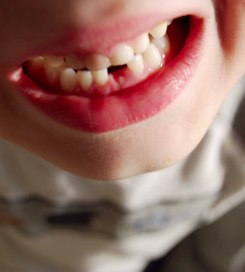Why Do We As A Culture Hand Our Children’s Teeth To A Strange Freak Fairy?
Posted by Justin on May 17th, 2010Each week, Weird Things’ own Matt Finley breaks down one of the oddest elements of our culture in a feature we call Monster Of The Week. This week we focus on the Tooth Fairy, come back Wednesday and Friday for more!
 More than just the story of a shrewd harpy with brimming coffers and an inexplicable calcium fetish, the legend of the tooth fairy is a tale of a Western superstition’s complete 180 degree turn from paranoid delusion to celebratory rite (I’m ignoring the recent additional 10-degree nudge toward Dwayne Johnson-helmed cinematic atrocity). But before we take a look at the wand-assisted incisor seizure perpetrated by she of the glittery wings and deep pockets, we need to look at baby teeth. Now they’re commodities, but back in the olden days, the exchange rate wasn’t so favorable. Today an exfoliated molar might fetch you a couple dollars; a few hundred years ago, the best you could hope was to not be fatally hexed by dark magicks.
More than just the story of a shrewd harpy with brimming coffers and an inexplicable calcium fetish, the legend of the tooth fairy is a tale of a Western superstition’s complete 180 degree turn from paranoid delusion to celebratory rite (I’m ignoring the recent additional 10-degree nudge toward Dwayne Johnson-helmed cinematic atrocity). But before we take a look at the wand-assisted incisor seizure perpetrated by she of the glittery wings and deep pockets, we need to look at baby teeth. Now they’re commodities, but back in the olden days, the exchange rate wasn’t so favorable. Today an exfoliated molar might fetch you a couple dollars; a few hundred years ago, the best you could hope was to not be fatally hexed by dark magicks.
To lay a wicked pox on someone’s house, all a witch needs is a sample of the victim’s DNA and some elbow grease (preferably that of a middle-order demon, notorious as they are for their excessively greasy elbows). Or, at least, such was the belief of many ancient civilizations, who devised all manner of creative disposal methods for nail clippings, hair sheerings and disenjawed teeth. Hair and nails (along with samples of urine and menstrual blood) were often relegated to hidden witch bottles – ceramic or wooden vessels that, when intact, protected the owner against naughty mojo. Meanwhile, baby teeth were disposed of by a variety of regionally variant means, including burying, burning and swallowing. Some folks even tossed the derelict chompers into rats’ nests because, as you probably already know, if a mouse or a rat gnaws on a child’s lost milk tooth, the child’s permanent teeth will grow in healthy and strong.
Find the rest AFTER THE JUMP…
An observation: Over the last couple centuries, I’m sure these antiquated superstitions appeared increasingly ridiculous – who would believe that an errant stray hair or ill-discarded crescent of nail could be collected and used against its former body? Today, though, with the evolution of modern forensic techniques and DNA research (as recently as this past Friday, Walgreen’s began selling OTC consumer-grade genetic tests, and fingerprint ID cards are already starting to come into vogue), an increasing percentage of the population has become wary of, or least self-conscious about, the wider ramifications of their discarded genetic detritus.
All fairies, witches and lab techs aside, one thing that baby tooth lose has consistently represented is the first stumbling step toward adulthood. To this end, I find the evolution of tooth disposal – especially as it relates to Western Europe and, hence, America – fairly fascinating. Early Western Europeans, including those living in the British Isles, favored burying as the preferred method of milk tooth chucking. Relegating tooth to earth isn’t just an effective witch deterrent, but also a symbolic rite of passage – the child’s impending adulthood, and corresponding entry into self-sufficient agriculturalism, is represented by interring an icon of the child’s youth in the very soil he or she will be expected to tend, or else which carries much of his or her gross financial worth. Interesting, then, that this tradition gradually changed into a ritual involving the exchange of stray teeth for money. After all, in a capitalist, industrial society, short of pitching teeth into the whirring gears of some droning machine, what better way to induct a maturing child into the modern world than with an exchange of hard currency?
The larger point here – the 180 degree turn referred to above – is, of course, that ages ago, people stowed away their children’s teeth in a desperate attempt to keep the loose, vagrant bones away from the pernicious claws of magical beings. Today, people invite a magical being into their homes, and encourage her to steal their children’s teeth.
Who is this tooth fairy that we’ve come to trust with what once was so much in exchange for what, even now, is relatively little?
Wednesday – Weird Things Origins: The Tooth Fairy